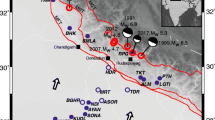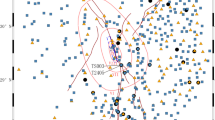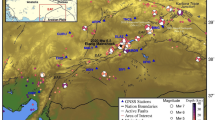Abstract
On 30 October 2020 a MW 7.0 earthquake occurred in the eastern Aegean Sea, between the Greek island of Samos and Turkey’s Aegean coast, causing considerable seismic damage and deaths, especially in the Turkish city of Izmir, approximately 70 km from the epicenter. In this study, we provide a detailed description of the Samos earthquake, starting from the fault rupture to the ground motion characteristics. We first use Interferometric Synthetic Aperture Radar and Global Positioning System data to constrain the source mechanisms. Then, we utilize this information to analyze the ground motion characteristics of the mainshock in terms of peak ground acceleration (PGA), peak ground velocity, and spectral pseudo-accelerations. Modelling of geodetic data shows that the Samos earthquake ruptured a NNE-dip** normal fault located offshore north of Samos, with up to 2.5–3 m of slip and an estimated geodetic moment of 3.3 ⨯ 1019 Nm (MW 7.0). Although low PGA were induced by the earthquake, the ground shaking was strongly amplified in Izmir throughout the alluvial sediments. Structural damage observed in Izmir reveals the potential of seismic risk due to the local site effects. To better understand the earthquake characteristics, we generated and compared stochastic strong ground motions with the observed ground motion parameters as well as the ground motion prediction equations, exploring also the efficacy of the region-specific parameters which may be used to better predict the expected ground shaking from future large earthquakes in the region.













Similar content being viewed by others
References
AFAD (2020) Turkish accelerometric database and analysis system. https://tadas.afad.gov.tr/eventdetail/11995. Accessed 20 Nov 2020
Akinci A, Antonioli A (2012) Observations and stochastic modelling of strong ground motions for the 2011 October 23 Mw 7.1 Van, Turkey, earthquake. Geophys J Int 192:1217–1239. https://doi.org/10.1093/gji/ggs075
Akinci A, Malagnini L, Herrmann RB et al (2006) Ground motion scaling in the Marmara region, Turkey. Geophys J Int 166:635–651. https://doi.org/10.1111/j.1365-246x.2006.02971.x
Akinci A, Malagnini L, Sabetta F (2010) Characteristics of the strong ground motions from the 6 April 2009 L’Aquila earthquake Italy. Soil Dyn Earthq Eng 30:320–335
Akinci A, D’Amico S, Malagnini L, Mercuri A (2013) Scaling earthquake ground motions in western Anatolia, Turkey. Phys Chem Earth Parts a/b/c 63:124–135. https://doi.org/10.1016/j.pce.2013.04.013
Akinci A, Malagnini L, Herrmann RB, Kalafat D (2014) High-frequency attenuation in the Lake Van Region, Eastern Turkey. Bull Seismol Soc Am 104:1400–1409. https://doi.org/10.1785/0120130102
Akkar S, Caglar NM, Kale O, Yazgan U, Sandikkaya MA (2021) Impact of rupture-plane uncertainty on earthquake hazard: observations from the 30 October 2020 Samos earthquake. Bull Earthq Eng 19:2739–2761. https://doi.org/10.1007/s10518-021-01099-9
Akkar S, Cagnan Z (2010) A Local Ground-Motion Predictive Model for Turkey and Its Comparison with Other Regional and Global Ground-Motion Models. Bull Seismol Soc Am 100(6):2978–2995. https://doi.org/10.1785/0120090367
Aktar M, Karabulut H, Özalaybey S, Childs D (2007) A conjugate strike-slip fault system within the extensional tectonics of Western Turkey. Geophys J Int 171:1363–1375. https://doi.org/10.1111/j.1365-246x.2007.03598.x
Akyol N, Zhu L, Mitchell BJ et al (2006) Crustal structure and local seismicity in western Anatolia. Geophys J Int 166:1259–1269. https://doi.org/10.1111/j.1365-246x.2006.03053.x
Ambraseys NN (2009) Earthquakes in the Mediterranean and Middle East: a multidisciplinary study of seismicity up to 1900. Cambridge University Press, Cambridge (ISBN: 978‐0‐521‐87292‐8)
Anderson JG, Hough SE (1984) A model for the shape of the Fourier amplitude spectrum of acceleration at high frequencies. Bull Seismol Soc Am 74:1969–1993
Baise LG, Kaklamanos J, Berry BM, Thompson EM (2016) Soil amplification with a strong impedance contrast: Boston, Massachusetts. Eng Geol 202:1–13. https://doi.org/10.1016/j.enggeo.2015.12.016
Banab KK, Kolaj M, Motazedian D et al (2012) Seismic site response analysis for Ottawa, Canada: a comprehensive study using measurements and numerical simulations. Bull Seismol Soc Am 102:1976–1993. https://doi.org/10.1785/0120110248
Bjerrum LW, Sørensen MB, Ottemöller L, Atakan K (2013) Ground motion simulations for İzmir, Turkey: parameter uncertainty. J Seismolog 17:1223–1252. https://doi.org/10.1007/s10950-013-9389-9
Bonilla LF (2002) Borehole response studies at the garner valley downhole array Southern California. Bull Seismol Soc Am 92(8):3165–3179. https://doi.org/10.1785/0120010235
Boore DM (2003) Simulations of ground motion using the stochastic method. Pure Appl Geophys 160:635–675
Boore DM (2009) Comparing stochastic point-source and finite-source ground-motion simulations: SMSIM and EXSIM. Bull Seismol Soc Am 99:3202–3216. https://doi.org/10.1785/0120090056
Boore DM (2013) The uses and limitations of the square-root-impedance method for computing site amplification. Bull Seismol Soc Am 103:2356–2368. https://doi.org/10.1785/0120120283
Boore DM, Joyner WB (1997) Site amplification for generic rock sites. Bull Seismol Soc Am 87:327–341
Boore DM, Joyner WB, Fumal TE (1994) Estimation of response spectra and peak accelerations from western North American earthquakes: an interim report, Part 2, U.S. Geol. Surv. Open-File Rept. 94–127, pp 40
Boore DM, Thompson EM, Cadet H (2011) Regional correlations of VS30 and velocities averaged over depths less than and greater than 30 meters. Bull Seismol Soc Am 101:3046–3059. https://doi.org/10.1785/0120110071
Boore DM, Stewart JP, Seyhan E, Atkinson GM (2014) NGA-West2 equations for predicting PGA, PGV, and 5% damped PSA for shallow crustal earthquakes. Earthq Spectra 30:1057–1085. https://doi.org/10.1193/070113eqs184m
Borcherdt RD (1970) Effects of local geology on ground motion near San Francisco Bay. Bull Seismol Soc Am 60:29–61
CEN (2004) EN1998-1: Design of structures for earthquake resistance, Part 1: general rules, seismic actions and rules for buildings, Brussels: European Committee for Standardization
Cetin OK, Mylonakis G, Sextos A, Stewart JP (2020) Seismological and engineering effects of the M 7.0 Samos Island (Aegean Sea) Earthquake, geotechnical extreme events reconnaissance association: Report GEER-069,https://doi.org/10.18118/G6H88
Chatzipetros A, Kiratzi A, Sboras S, Zouros N, Pavlides S (2013) Active faulting in the north-eastern Aegean Sea Islands. Tectonophysics 597–598:106–122: https://doi.org/10.1016/j.tecto.2012.11.026
Cheloni D, Akinci A (2020) Source modelling and strong ground motion simulations for the 24 January 2020, Mw 6.8 Elazığ earthquake. Turk Geophys J Int 223:1054–1068. https://doi.org/10.1093/gji/ggaa350
Cheloni D, Falcucci E, Gori S (2019) Half-graben rupture geometry of the 30 October 2016 MW6.6 Mt. Vettore-Mt. Bove Earthquake, Central Italy. J Geophys Res Solid Earth 124:4091–4118. https://doi.org/10.1029/2018jb015851
Chen CW, Zebker HA (2001) Two-dimensional phase unwrap** with use of statistical models for cost functions in nonlinear optimization. J Opt Soc Am 18(2):338–351
Çubuk-Sabuncu Y, Taymaz T, Fichtner A (2017) 3-D crustal velocity structure of western Turkey: constraints from full-waveform tomography. Phys Earth Planet Inter 270:90–112. https://doi.org/10.1016/j.pepi.2017.06.014
Duman TY, Çan T, Emre Ö et al (2018) Seismotectonic database of Turkey. Bull Earthq Eng 16:3277–3316. https://doi.org/10.1007/s10518-016-9965-9
Erdik M, Demircioğlu MB, Cüneyt T (2020) Forensic analysis reveals the causes of building damage in İzmir in the Oct. 30 Aegean Sea earthquake. Temblor. https://doi.org/10.32858/temblor.139
Field EH, Jacob KH (1995) A comparison and test of various site-response estimation techniques, including three that are not reference-site dependent. Bull Seism Soc Am 85:1127–1143
Ganas A, Panagiotis E, Briole P, Tsironi V, Valkaniotis S, Escartin J, Karasante I, Efstathiou E (2020) Fault responsible for Samos earthquake identified. Temblor. https://doi.org/10.32858/temblor.134
General directorate of mineral research and exploration, geology map, http://yerbilimleri.mta.gov.tr/anasayfa.aspx, Accessed Dec 2020 (in Turkish)
U.S. Geological Survey (2020) Earthquake hazards program, available at: https://www.usgs.gov/natural-hazards/earthquake-hazards/earthquakes, Accessed Jan 2021
Gok E, Polat O (2014) An assessment of the microseismic activity and focal mechanisms of the Izmir (Smyrna) area from a new local network (IzmirNET). Tectonophysics 635:154–164. https://doi.org/10.1016/j.tecto.2014.08.003
Goldstein RM, Werner CL (1998) Radar interferogram filtering for geophysical applications. Geophys Res Lett 25:4035–4038. https://doi.org/10.1029/1998gl900033
Haskell NA (1960) Crustal reflection of plane SH waves. J Geophys Res 65:4147–4150
Jarvis A, Reuter HI, Nelson A, Guevara E (2008) Hole-filled SRTM for the globe, version4, CGIAR-CSI SRTM 90m Database, available at http://srtm.csi.cgiar.org
Joyner WB, Fumal TE (1985) Use of measured shear-wave velocity for predicting geologic site effects on strong ground motion, in Proc. Eighth World Conf. on Earthquake Eng., San Francisco, Vol 2, 777–783
KOERI (2020) Kandilli observatory and earthquake research institute, Istanbul-Turkey. http://koeri.boun.edu.tr. Accessed 15 Jan 2021 (in Turkish)
Kouskouna V, Sakkas G (2013) The University of Athens hellenic macroseismic database (HMDB.UoA): historical earthquakes. J Seismolog 17:1253–1280. https://doi.org/10.1007/s10950-013-9390-3
Kurtulmuş TÖ, Akyol N (2013) Crustal attenuation characteristics in western Turkey. Geophys J Int 195:1384–1394. https://doi.org/10.1093/gji/ggt318
Lermo J, Chávez-García FJ (1993) Site effect evaluation using spectral ratios with only one station. Bull Seismol Soc Am 83:1574–1594
Lohman RB, Simons M (2005) Some thoughts on the use of InSAR data to constrain models of surface deformation: noise structure and data downsampling. Geochem Geophys Geosyst. https://doi.org/10.1029/2004gc000841
Makropoulos K, Kaviris G, Kouskouna V (2012) An updated and extended earthquake catalogue for Greece and adjacent areas since 1900. Nat Hazard 12:1425–1430. https://doi.org/10.5194/nhess-12-1425-2012
Malagnini L, Mayeda K, Akinci A, Bragato PL (2004) Estimating absolute site effects. Bull Seismol Soc Am 94(4):1343–1352
Malagnini L, Nielsen S, Mayeda K, Boschi E (2010) Energy radiation from intermediate- to large-magnitude earthquakes: implications for dynamic fault weakening. J Geophys Res. https://doi.org/10.1029/2009jb006786
McKenzie D (1978) Active tectonics of the Alpine-Himalayan belt: the Aegean Sea and surrounding regions. Geophys J Roy Astr Soc 55(1):217–254
Metropolitan Municipality of İzmir (MMI) (2000) İzmir earthquake masterplan. Metropolitan Municipality of İzmir publication, İzmir, Turkey. http://www.izmir.bel.tr/izmirdeprem/izmirrapor.htm. Last accessed 11 Jan 2021. (in Turkish)
Ministry of Urbanization and Environment (2020) Assessment Reports, https://hasartespit.csb.gov.tr/, Accessed on 14 Dec, 2020 (in Turkish)
Molnar S (2004) Site response in Victoria, British Columbia, from spectral ratios and 1D modeling. Bull Seismol Soc Am 94:1109–1124. https://doi.org/10.1785/0120030195
Motazedian D (2005) Stochastic finite-fault modeling based on a dynamic corner frequency. Bull Seismol Soc Am 95:995–1010. https://doi.org/10.1785/0120030207
Nakamura Y (1989) A method for dynamic characteristics estimation of subsurface using microtremor on the ground surface. Q Rep Railw Tech Res Inst 30(1):25–33
Ocakoğlu N, Demirbağ E, Kuşçu İ (2004) Neotectonic structures in the area offshore of Alaçatı Doğanbey and Kuşadası (western Turkey): evidence of strike-slip faulting in the Aegean extensional province. Tectonophysics 391(1–4):67–83. https://doi.org/10.1016/j.tecto.2004.07.008
Okada Y (1985) Surface deformation due to shear and tensile faults in a half-space. Bull Seismol Soc Am 75:1135–1154
Pamuk E, Gönenç T, Özdağ ÖC, Akgün M (2018a) 3D Bedrock structure of Bornova Plain and its surroundings (İzmir/Western Turkey). Pure Appl Geophys 175:325–340. https://doi.org/10.1007/s00024-017-1681-0
Pamuk E, Özdağ ÖC, Akgün M (2018b) Soil characterization of Bornova Plain (Izmir, Turkey) and its surroundings using a combined survey of MASW and ReMi methods and Nakamura’s (HVSR) technique. Bull Eng Geol Env 78:3023–3035. https://doi.org/10.1007/s10064-018-1293-7
Pischiutta M, Akinci A, Tinti E, Herrero A (2020) Broad-band ground-motion simulation of 2016 Amatrice earthquake, Central Italy. Geophys J Int 224:1753–1779. https://doi.org/10.1093/gji/ggaa412
Pratt TL, Horton JW, Muñoz J et al (2017) Amplification of earthquake ground motions in Washington, DC, and implications for hazard assessments in Central and Eastern North America. Geophys Res Lett 44(12):150–160. https://doi.org/10.1002/2017gl075517
SESAME team 2004 Guidelines for the implementation of the H/V spectral ratio technique on ambient vibrations: measurements, processing and interpretation, SESAME European research project
Soysal H, Sipahioglu S, Kolcak D, Altinok Y (1981) Turkiye ve Cevresinin Tarihsel deprem Katalogu. TUBITAK, Proje no. TBAG 341, Istanbul, pp 86. (in Turkish)
Sözbilir H, Sümer Ö, Uzel B, Ersoy Y, Erkül F, İnci U, Helvacı C, Özkaymak Ç (2009) The Seismic geomorphology of the Sığacık Gulf (İzmir) earthquakes of October 17 to 20, 2005 and their relationships with the stress field of their Western Anatolian region. Geol Bull Turk 52(2):217–238
Stark PB, Parker RL (1995) Bounded-variable least-squares algorithm—an algorithm and implications. Comput Stat 10(2):129–141
Stiros SC, Laborel J, Laborel-Deguen F, Papageorgiou S, Evin J, Pirazzoli PA (2000) Seismic coastal uplift in a region of subsidence: holocene raised shorelines of Samos Island Aegean Sea Greece. Marine Geol 170(1–2):41–58. https://doi.org/10.1016/S0025-3227(00)00064-5
Styron R, Pagani M (2020) The GEM global active faults database. Earthq Spectra 36:160–180. https://doi.org/10.1177/8755293020944182
Tan O, Papadimitriou EE, Pabucçu Z et al (2014) A detailed analysis of microseismicity in Samos and Kusadasi (Eastern Aegean Sea) areas. Acta Geophys 62:1283–1309. https://doi.org/10.2478/s11600-013-0194-1
Taymaz T, Jackson J, Mckenzie D (1991) Active tectonics of the north and central Aegean Sea. Geophys J Int 106:433–490. https://doi.org/10.1111/j.1365-246x.1991.tb03906.x
Turkish Building Earthquake Code (TBEC) (2018) Disaster and emergency management presidency, Ankara, Turkey (in Turkish)
Turkish Seismic Code (TSC) (2007) Ministry of public works and settlement, Ankara, Turkey (in Turkish)
Turkish Statistical Institute (2021) Residential building permits. https://data.tuik.gov.tr/. Accessed 15 Jan 2021 (in Turkish)
Uzel B, Sözbilir H, Özkaymak Ç et al (2013) Structural evidence for strike-slip deformation in the İzmir-Balıkesir transfer zone and consequences for late Cenozoic evolution of western Anatolia (Turkey). J Geodyn 65:94–116. https://doi.org/10.1016/j.jog.2012.06.009
Vernant P, Reilinger R, Mcclusky S (2014) Geodetic evidence for low coupling on the Hellenic subduction plate interface. Earth Planet Sci Lett 385:122–129. https://doi.org/10.1016/j.epsl.2013.10.018
Yilmaz Y, Genç ŞC, Gürer F, Bozcu M, Yilmaz K, Karacik Z, Altunkaynak Ş, Elmas A (2000) When did the western anatolian grabens begin to develop? Geol Soc Lond Spec Publ 173(1):353–384. https://doi.org/10.1144/GSL.SP.2000.173.01.17
Zandieh A, Pezeshk S (2011) A study of horizontal-to-vertical component spectral ratio in the New Madrid seismic zone. Bull Seismol Soc Am 101:287–296. https://doi.org/10.1785/0120100120
Zhu L, Mitchell BJ, Akyol N et al (2006) Crustal thickness variations in the Aegean region and implications for the extension of continental crust. J Geophys Res. https://doi.org/10.1029/2005jb003770
Acknowledgements
Most of the figures have been created using the Generic Map** Tool version 4.2.1 (www.soest.hawaii.edu/gmt) and the Seismic Analysis Code (SAC) software IRIS SeisCode (washington.edu). We use Copernicus Sentinel-1 InSAR imagery (https://scihub.copernicus.eu/). Sentinel-1 data are copyright of Copernicus (2020). We thank Athanassios Ganas of the National Observatory of Athens for sharing GPS data. The strong motion data used in this study were obtained from the Earthquake Department of the Disaster and Emergency Management Presidency, AFAD, Kandilli Observatory and earthquake Research Institute, KOERI. We thank everyone who contributed to this matter. We thank Gail Atkinson, Dariush Motazedian, and David Boore for providing the computer code to generate ground motion simulations (EXSIM). Some of the amplifications are computed using the programs site_amp and nrattle, available from the online software link at www.daveboore.com. Authors would like to thank Simon J. Ellis for the correction of English style, grammar and spelling. We thank R. B. Herrmann from Saint Louis University for his helpful contribution on the earthquake magnitude and the moment tensor solution.
Author information
Authors and Affiliations
Corresponding author
Additional information
Publisher's Note
Springer Nature remains neutral with regard to jurisdictional claims in published maps and institutional affiliations.
Supplementary Information
Below is the link to the electronic supplementary material.
Rights and permissions
About this article
Cite this article
Akinci, A., Cheloni, D. & Dindar, A.A. The 30 October 2020, M7.0 Samos Island (Eastern Aegean Sea) Earthquake: effects of source rupture, path and local-site conditions on the observed and simulated ground motions. Bull Earthquake Eng 19, 4745–4771 (2021). https://doi.org/10.1007/s10518-021-01146-5
Received:
Accepted:
Published:
Issue Date:
DOI: https://doi.org/10.1007/s10518-021-01146-5




